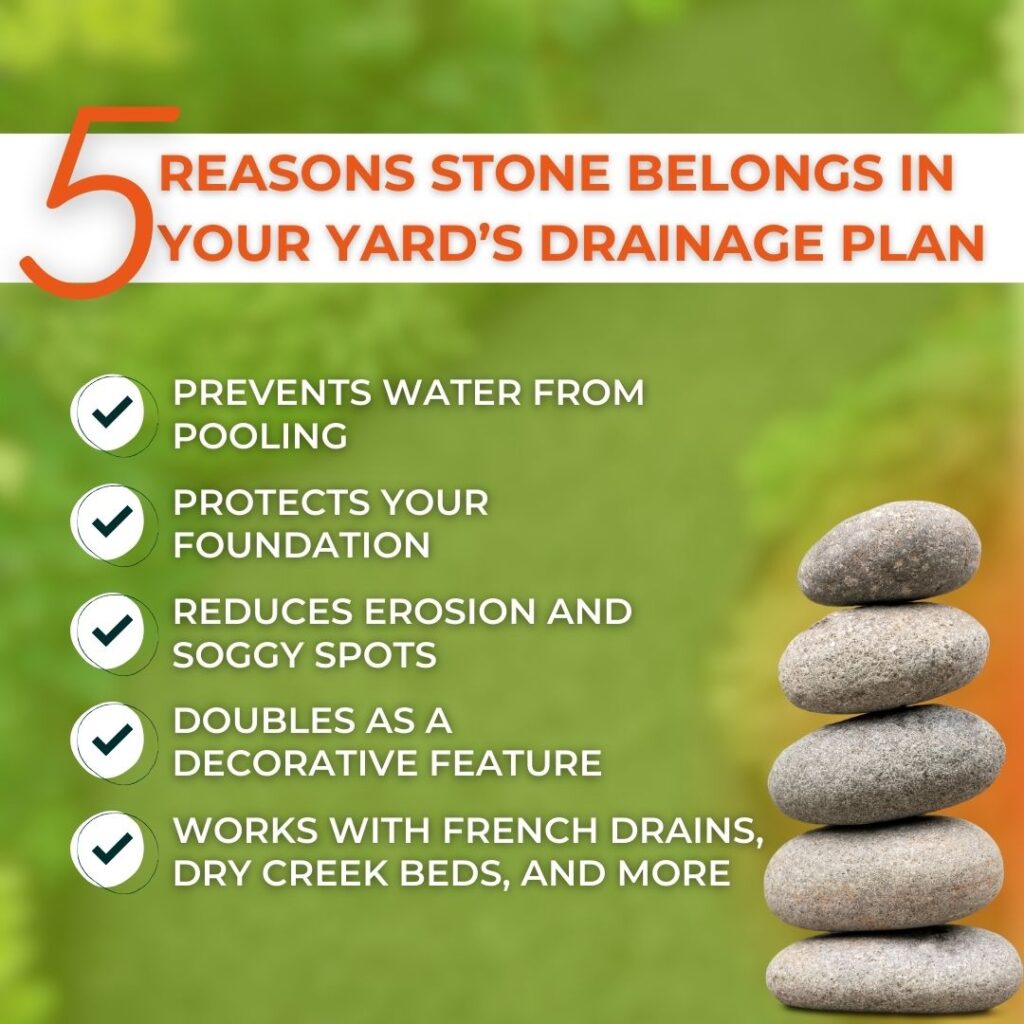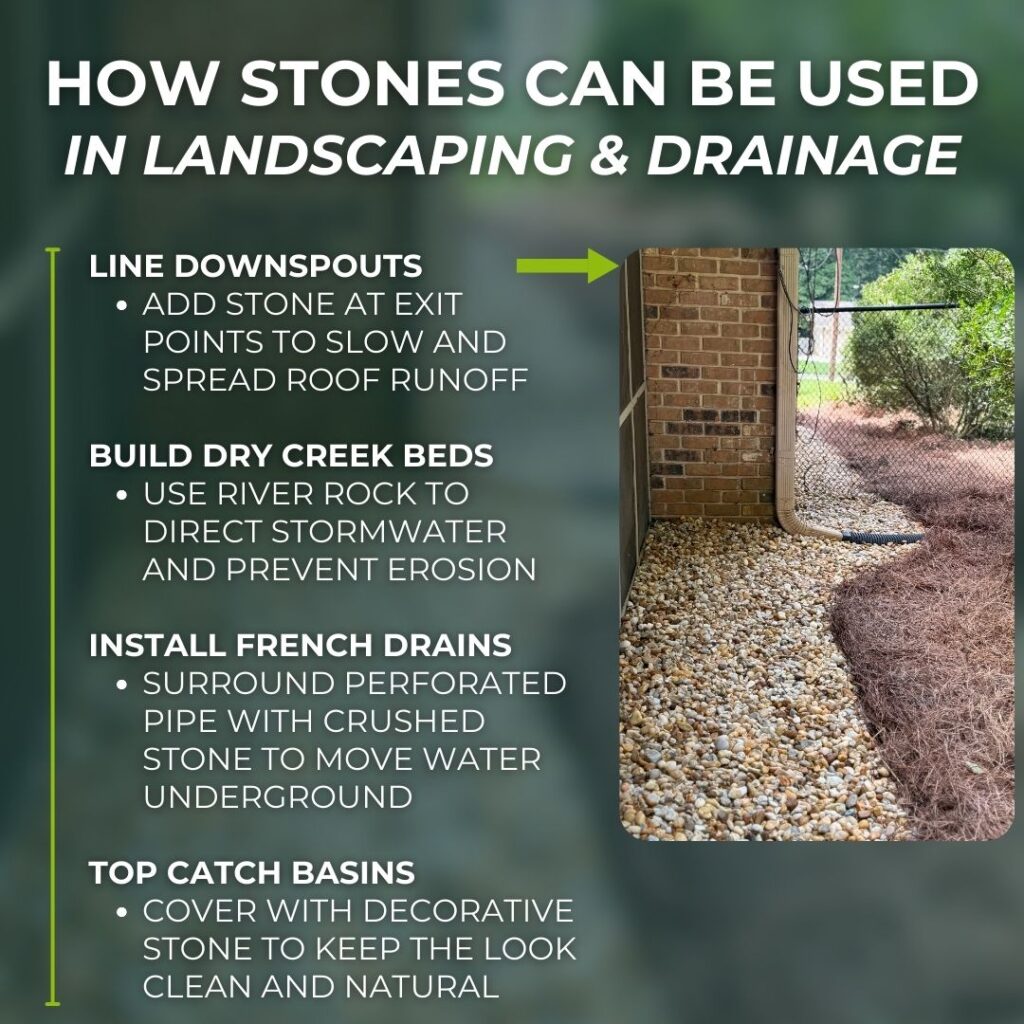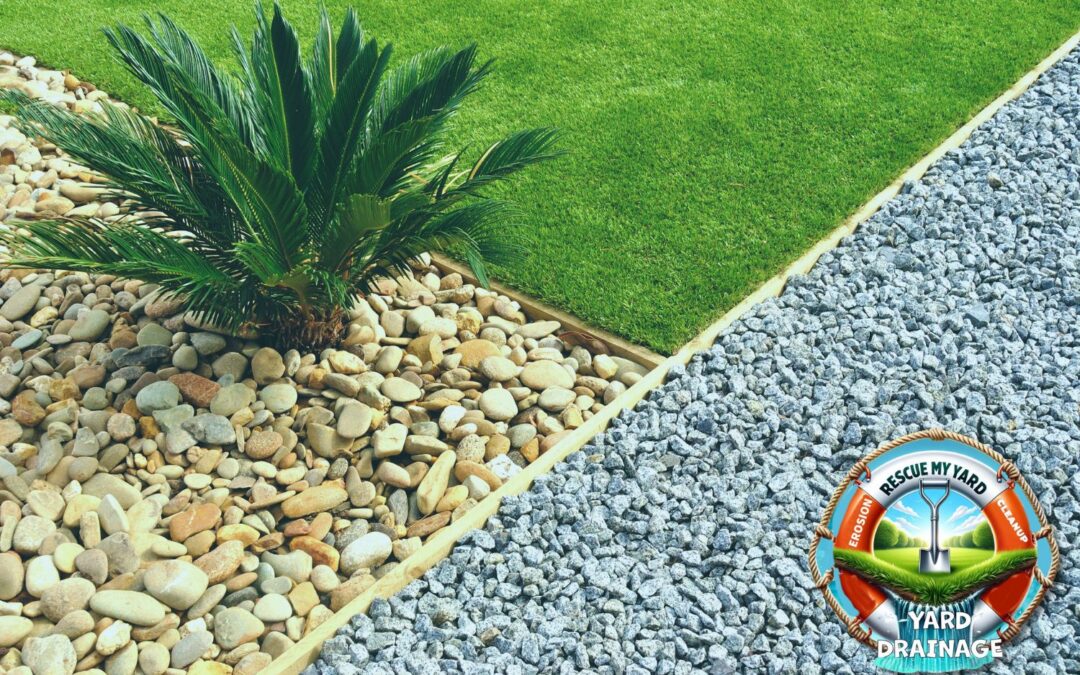Whether you’re dealing with Georgia clay, heavy rain, or poor soil absorption, this guide will help you choose the best stone-based landscaping ideas as solutions for your yard.
Water can make or break your yard. Too little, and your lawn dries out. Too much, and you’re dealing with soggy spots, erosion, and even foundation issues. One of the smartest ways to manage water and protect your outdoor space is with the right landscaping and drainage strategies.
Stone is more than a decorative feature. When used correctly, it becomes part of a functional drainage system that directs water away from your home and keeps your lawn healthy year-round.
Why Drainage Should Be Part of Landscape Planning
A beautiful yard starts with proper water flow. If water collects near your home, or you see puddles that last more than a day, your drainage needs help.
Also, look up. Your roof sheds hundreds of gallons of water during a storm, and if downspouts aren’t extended far enough or angled properly, all that runoff can pool right next to your foundation.
Standing water and unmanaged runoff can cause:
- Lawn disease and grass die-off
- Muddy walkways and pest problems
- Washed-out mulch or soil erosion
- Damage to your home’s foundation
In Georgia’s climate, these issues are common, especially after summer thunderstorms. The CDC also notes that standing water attracts mosquitoes, which can carry diseases like West Nile virus. That makes drainage a health concern as well as a landscape issue.

How Stone Helps With Drainage
Stone doesn’t absorb water, but it allows it to flow through. Unlike compacted soil, stone offers space between pieces for water to drain. When layered properly and paired with features like drains or trenches, it directs water safely away from problem areas.
For a few ideas, here are common types of stone used for drainage and landscaping:
- River rock: Smooth and rounded, often used in dry creek beds
- Crushed stone: Jagged, irregular, and perfect for French drains
- Pea gravel: Small and uniform, ideal for walkways or around patios
- Larger decorative rocks: Often used to slow water in downspout zones
Each option has different textures, weights, and drainage capabilities. A professional landscaper or drainage expert can help match the right type to your specific yard conditions.
Smart Drainage Ideas That Use Stone
These solutions combine the power of proper grading, functional design, and natural materials to keep water under control and out of your way.
1. French Drains with Crushed Stone
French drains are underground systems designed to collect and redirect water. They consist of a perforated pipe surrounded by crushed stone, wrapped in filter fabric. Water flows into the pipe through the stone and is carried away from the home.
This is one of the most effective solutions for saturated areas, especially near the foundation or in low-lying parts of the yard. Rescue My Yard installs custom French drains designed for Georgia’s unique soil and slope challenges.
2. Dry Creek Beds with River Rock
Dry creek beds are shallow, stone-lined channels that mimic the look of a natural stream. They collect runoff during heavy rain and allow it to move across the yard without causing damage.
This is a great option for homeowners who want both form and function. A dry creek bed can add a decorative element to your landscape while also solving erosion and pooling problems.
3. Stone Borders for Downspouts
When water pours out of your downspouts, it can erode soil, kill plants, and flood nearby areas. Lining the exit area with stone (such as pea gravel or small river rock) helps slow the water and protect the ground below.
In some cases, a downspout extension or buried drain pipe may be added for extra protection. Stone improves aesthetics and performance at the same time.
4. Gravel Walkways with Drainage Function
Gravel paths are not only affordable and attractive, but they also allow water to pass through the surface instead of pooling. If your yard has poor drainage in foot traffic areas, a gravel path can reduce muddy spots and still look intentional.
A compacted base, weed barrier, and edging help keep the gravel in place while maintaining its permeability.
5. Catch Basins with Decorative Stone Covers
Catch basins are boxes installed underground to collect surface runoff and connect to drain pipes. They’re often placed in areas that collect water, like near driveways or patio corners.
Topping them with decorative stone keeps the look natural while maintaining functionality. It also prevents debris from entering the drain and clogging the system.

Preventing Drainage Problems Before They Start
Installing stone drainage features is one step, but prevention also matters. Here’s what you can do to reduce future water issues:
- Keep gutters and downspouts clean and directed away from the house
- Avoid overwatering your lawn or plants
- Grade your yard so water flows away from structures
- Use mulch sparingly near the foundation
- Monitor for signs of soil compaction and correct with aeration when needed
Proper grading and drainage are essential for long-term yard health. A slope of just 1 inch per foot away from the foundation can make a big difference.
Related Questions About Stone Use Ideas for Landscaping
Can I use landscape fabric under gravel?
Yes. Landscape fabric helps prevent weeds while still allowing water to pass through. It also prevents stones from sinking into the soil over time.
How deep should a French drain be?
Most French drains are dug 18 to 24 inches deep. However, depth can vary depending on the slope and intended water flow.
How do I know if my yard needs a drainage system?
Look for signs like standing water after it rains, soggy patches that never dry, or soil washing away from garden beds. These are clear indicators that water isn’t draining properly. A professional can evaluate slope, soil type, and runoff to recommend the right fix.
Will stone landscaping affect my grass?
Not if installed correctly. In fact, stone can protect your lawn by redirecting excess water away from delicate areas, preventing root rot or washout.
When to Call an Expert
If you notice standing water after storms, areas of eroded soil, or mossy patches that never dry out, it’s time to get a professional opinion.
DIY fixes can help with small problems, but larger drainage issues often involve grading, buried pipes, or custom drainage solutions. Rescue My Yard specializes in solving water-related landscaping problems using long-lasting materials and expert design.
Whether it’s a new gravel path, a creek bed with river rock, or a full French drain system, professional installation saves time, improves curb appeal, and prevents recurring damage.
Conclusion
The right combination of stone and drainage ideas for your landscaping can completely transform your yard (and save you lots of trouble).
You’ll protect your lawn, keep your home’s foundation dry, and enjoy an outdoor space that’s functional and beautiful.
If you’re ready to stop dealing with puddles and soggy patches, a professional solution can help.

